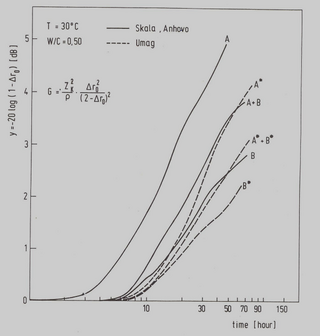1975–1979
Year 1975
As in the previous years, there were three bigger groups working in the Department of Condensed Matter Physics in 1975, namely the Magnetic Resonance Laboratory, the Electron Microscopy Laboratory, and the Plasma Physics Laboratory.
The work of the Magnetic Resonance Laboratory was carried out in four fundamental research areas:
- research in ferroelectrics and antiferroelectric,
- research in liquid crystals,
- development of new methods of magnetic resonance,
- transfer of experience gained by basic research in condensed matter physics to the fields of medicine, agronomy, chemical and electronics technology, and biophysics.
Research in ferroelectrics and antiferroelectrics was principally focused on studying the dynamics of phase transitions. First experimental evidence proving the existence of dynamic domains of the ferroelectric phase in the paraelectric phase was produced.
Whereas in previous years the researches devoted their efforts mainly to the physics of hard ferroelectrics, in 1975 they began for the first time to carry out research in the field of ferroelectric liquid crystals, which were only discovered in that same year.
Moreover, it is worth mentioning that in 1975 the Brillouin spectra of NaH3 (SeO3)2 was measured for the first time, and the temperature dependence of elastic constants in the ferroelectric phase transition was established.
Research in liquid crystals produced first measurements of the dispersion of nuclear spin-lattice relaxation times from the 0 Gauss field to the 20,000 Gauss field in smectic-A, -B, and -C phases of TBBA. Furthermore, the first model of nuclear spin-lattice relaxation in smectic systems was introduced. Another important discovery was that in smectic-C phases the molecules are aligned in layers in such a way that the tilt direction is constant only within one layer and changes from one layer to another.
As regards the development of new magnetic resonance methods, they developed a new nuclear double-resonance method, which is based on the coupling of spin systems I and S with a strong radio-frequency field, and enables the measuring of double-resonance spectra.
In the field of biophysical research, by using electron paramagnetic resonance and spin labels, the Department Staff discovered that the ordering of phospholipid layers in cell membranes of normal cells is weaker than in the membranes of malignant cells.
In relation to applied research, the making of a prototype of a pyroelectric infrared sensor on the basis of ferroelectric ceramics as well as the making of an optical display based on liquid crystals should be mentioned. A pulsed NMR spectrometer for non-destructive oil and moisture content determination in vegetable seeds was delivered to India.
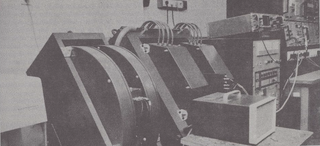
The Department cooperated with numerous other institutions in different fields: they continued with the research in cement hydration for the factory Salonit from Anhovo, they developed NMR methods for the characterisation of cancer tissues in collaboration with the Institute of Oncology, they further developed cryosurgical methods in cooperation with clinical hospitals, they introduced the utilization of liquid crystals for skin thermography together with the Institute of Gerontology and the Military Hospital, they researched tooth enamel with and without caries working with the Division of Stomatology, they also researched erythrocyte membranes in the field of pharmacy, with the Pathophysiological institute of the Faculty of Medicine they researched enzyme kinetics, they carried out NMR measurements of protein solutions for the Institute of Immunology Zagreb, and they cooperated with the Institute of Field and Vegetable Crops in Novi Sad.
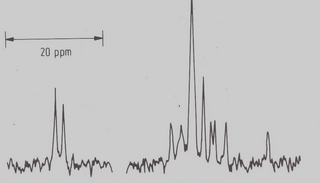
In 1975, the work of the Electron Microscopy Laboratory was carried out in four main directions also:
- research in order-disorder and metal-semiconductor phase transitions,
- research in structural defects and surface change induced by ion bombardment,
- research in structure and property of thin layers and procedures for their production,
- microstructure research for the needs of industry and other laboratories.
The laboratory reached new findings in all four areas, which were then extended for application in other fields; for example, in cooperation with the Salonit factory from Anhovo, the research of cement hydration was continued and it extended to the research of asbestos-cement corrosion. In 1975, the number of maintenance services for various laboratories and industrial companies increased.
The researchers in the Plasma Physics Laboratory carried out research on wave motion in plasma and magnetic fields, as well as on the creation of magnetic fields in dense plasma.
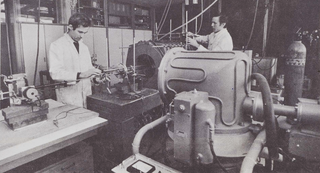
Year 1976
There were three laboratories operating within the Department of Condensed Matter Physics: the Magnetic Resonance Laboratory, the Electron Microscopy Laboratory, and the Plasma Physics Laboratory.
The Magnetic Resonance Laboratory expanded its work from four to five research areas:
- research in ferroelectrics and antiferroelectrics,
- research in liquid crystals,
- biophysics,
- development of new methods of magnetic resonance and new methods of laser light scattering,
- transfer of experience gained by basic research in condensed matter physics to applications in the fields of medicine, agronomy, chemical and electronics technology.
In 1976, the research in ferroelectrics and antiferroelectrics was focused on studying the orientational order of biaxial smectic liquid crystals, which can be either ferroelectric or antiferroelectric. New families of ferroelectrics and antiferroelectrics, which are isomorphic with PbHPO4 in the paraelectric phase, were studied as well. The researchers were also interested in the research of two-dimensional layered perovskites. However, it is the examination of possible uses of ferroelectrics for pyrotechnic detectors of thermal radiation and infrared laser light that represents a direct application of research in this field.
With regard to research in liquid crystals, it is particularly worth referring to measurements of the quadrupole coupling tensor of 14N nuclei in the smectic phases of TBBA, which represents the first utilization of nuclear quadrupole resonance in smectic systems.
Research in the field of biophysics was based on the study of lipid bilayers in living cell membranes with electron paramagnetic resonance of spin markers. They also researched the structure of the active site of the enzyme acetylcholinesterase. Furthermore, a characterisation of malignant tissue with magnetic resonances was carried out as well.
In the field of new methods of magnetic resonance, using a high-resolution superconducting magnet and “Fourier transform” techniques (NMR), they measured the change of chemical shift tensor in the ferroelectric phase transition. The obtained results demonstrated exceptional usefulness of this method for studying structural transitions in condensed matter.
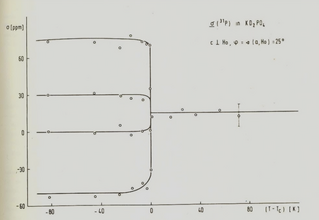
In 1976, at the request of International Atomic Energy Agency, a new automated pulsed NMR spectrometer for non-destructive oil and moisture content determination in vegetable seeds was sent to Bangladesh.
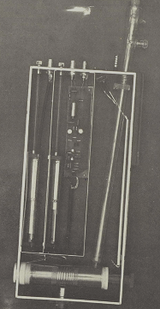
The Electron Microscopy Laboratory continued to carry out its work in four main directions:
- structure and properties of thin layers,
- microstructure of alloys and order-disorder transitions in inorganic crystals,
- surface change induced by ion bombardment,
- microstructure of some materials of practical importance for the needs of the economy and health system.
In cooperation with the Faculty of Electrical Engineering, a characterisation of sputtered resist thin layers of chromium, gold, nickel, tantalum and tantalum nitride was done in the framework of the project “Integrated circuits”. In this context, the effect of incorporation of inert gasses for electric properties of layers by thermal resorption and structure pursuit with electron microscopy was determined. Moreover, conditions under which sputtered layers with the highest quality are produced were specified.
In relation to structural changes caused by ion bombardment, it is worth mentioning the research in blistering of different types of stainless steel, molybdenum, and vanadium. The results of the research showed that the changes in stainless steels are irregular.
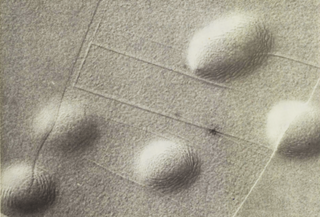
In the field of microstructure research, the method of thinning the specimen for transmission electron microscopy with ion erosion was mastered. The method proved successful for thinning of various asbestos-cement products in the framework of research for Salonit from Anhovo and for the preparation of tooth enamel samples in relation to research in caries.
In 1976, the Plasma Physics Laboratory worked on researching the emergence and propagation of intense electromagnetic radiation through plasma. They also acquired a new device for studying plasma in a magnetic field.
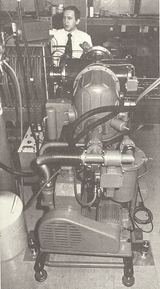
Year 1977
The following laboratories were operating in the Department of Condensed Matter Physics: the Nuclear Magnetic Resonance Laboratory, the Electron Magnetic Resonance Laboratory, the Laser Light Scattering Laboratory, the Dielectric Spectroscopy Laboratory, and the Ultrasound Measurements Laboratory.
The work of the Department in 1977 was carried out in the following main directions:
- research in the nature of ferroelectrics and antiferroelectrics,
- research in smectic, nematic and lyotropic liquid crystals,
- biophysics,
- development of new methods of magnetic resonance,
- transfer of experience gained by basic research in condensed matter physics to applications in the fields of chemical and electronics technology, food industry, agronomy, and medicine.
It is worth mentioning in relation to research in ferroelectrics and antiferroelectrics that the elementary excitation spectrum of ferroelectric liquid crystals, where during a phase transition into the polar phase the continuous symmetry is broken, rather than the discrete one as with hard ferroelectrics, was determined for the first time.
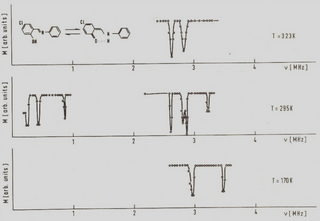
In the field of magnetic resonance the researchers resolved a problem which had remained unsolved for more than 20 years: they discovered the cause of thermochromic effects in n-salicylideneanilines. They proved that the changing of colour due to changes in temperature is a consequence of proton transfer in hydrogen bond O–H…N – O…H–N.
In the framework of research in liquid crystals, a structure of a special group of lyotropic liquid crystals, which can be orientated in an external magnetic field, was defined, and spin-lattice relaxation due to anisotropic diffusion in nematic systems was calculated.
The the research in biophysics focused on fluidity of living cell membranes and the structure of active centres of enzymes with spin markers. The researchers were also interested in the nature of muscle contraction with the help of naturally present paramagnetic centres in tissues. They researched liposomes and lyotropic liquid crystals as models of cell membranes and continued studying the characterisation of malignant tissues with magnetic resonances and water binding on biological macromolecules.
In relation to the development of new methods of magnetic resonance, it should be mentioned that a study of high-resolution 13C NMR spectra in crystals with proton enhanced nuclear induction spectroscopy was conducted. This method was used to research the nature of ferroelectric transition in Rochelle salt and the structure of hydrogen bonds in potassium hydrogen‑trichloroacetate, and for characterisation of polymers and coals. Using this method, the researchers also managed to non-destructively determine the ratio between protein and carbohydrate contents in maize grains, thus discovering a new method for cereal selection. Moreover, they developed a method for measuring NMR and EPR spectra under pressures.
In the field of applied research the technology for producing optical indicators based on liquid crystals and dynamic light scattering was mastered in collaboration with the Iskra cooperative enterprise. Another successful cooperation was with the Lek factory in non-destructive determination of oil content in ergots. The Department also continued to cooperate with the Salonit Anhovo factory. Together, they were developing a new NMR method for determining the quality and characteristics of cements. With the help of the discovered linear relation between the speed of spin-lattice relaxation of adsorbed water protons and compressive and flexural strength of cements, the researchers managed to introduce a new, quick non-destructive method for simultaneous control of cements, additives and admixtures. In 1977, the Department constructed and then delivered to Bangladesh a NMR spectrometer for non-destructive determination of oil quality and quantity in cereals.
Year 1978
In 1978, the work in the Department of Condensed Matter Physics was carried out in five laboratories:
- Nuclear Magnetic Resonance Laboratory,
- Electron Magnetic Resonance Laboratory,
- Laser Light Scattering Laboratory,
- Dielectric Spectroscopy Laboratory,
- Ultrasound Measurements Laboratory.
Additionally, three applied research groups started working alongside the laboratories:
- research group for application of liquid crystals,
- research group for application of ferroelectrics,
- research group for utilization of NMR.
Research in 1978 was characterised by a close interlacement of basic and applied research as well as by utilization of different techniques to solve the problems occurring in condensed matter physics.
Researchers were active in the following areas:
- research in nature and dynamics of ferroelectrics and antiferroelectrics with a special focus on the influence of crystal lattice dimensionality,
- research in liquid crystals,
- research in membrane biophysics,
- transfer of experience gained by basic research in condensed matter physics to applications in the fields of electronics, agronomy, medicine, and food and cement industries.
Within the research in ferroelectrics and antiferroelectrics we shoul point out the research of pseudo‑one‑dimensional system CsH2PO4, which, in contrast with three-dimensional systems, shows non-classical critical exponents.
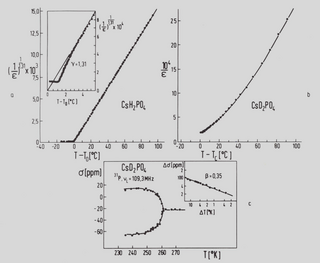
Research in liquid crystals showed that an electric field can induce the so-called Lifshitz point in chiral smectic liquid crystals. This phenomenon was important from the theoretical point of view since it represented a new type of tricritical point and had large experimental significance at the same time, as it could be used for a new type of electrochromic optical indicators.
Using nuclear double resonance, the parameters of orientational order in the smectic C, smectic H, and smectic IV phases of chiral and achiral liquid crystals were measured for the first time in 1978. The researchers also formulated the theory of spin-lattice relaxation due to anisotropic diffusion in smectic and nematic liquid crystals, which proved useful for the problems of polymers and adsorbed water on the DNA.
Biophysical research focused on studying the structure and functions of somatic cell membranes and models with the help of spin markers that incorporated into the membranes and used to study the fluidity of lipid bilayers and structural parameters of membrane enzymes. They discovered that, at the same concentration of water in tissue, the proton spin‑lattice relaxation time T1 is longer in malignant brain tumours than in the benign ones. The relation between the changing of free radical concentration in tissues and muscle contraction was also researched.
When considering the cooperation with other fields and achieving applied value of research, we should mention research in cement hydration, which proved that there is a linear corelation between the speed of spin-lattice relaxation of adsorbed water protons and the mechanical strength of cements, and that it is possible to determine the active surface and the ultimate strength of cements by measuring the nuclear relaxation times. In the field of the utilization of ferroelectrics, a pyroelectric detector was developed and a prototype of passive thermal alarm device was made. In the framework of the utilization of liquid crystals, the making of digital optical indicators and digital liquid-crystal thermometers was mastered, whereas in connection to the utilization of NMR, an integrated portable NMR process analyser for a rapid, automated and non-destructive analysis of oil and moisture content in seeds, grains, and food products was made. The oil NMR analyser was delivered to an oil mill in Sombor.
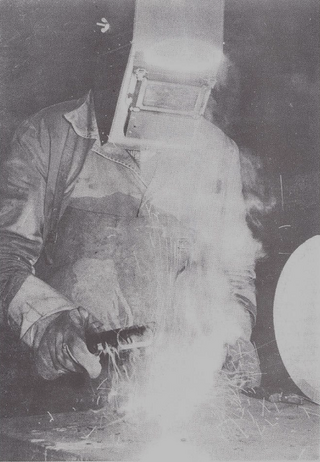
Year 1979
In 1979, there were five laboratories operating within the Department of Condensed Matter Physics:
- Nuclear Magnetic Resonance Laboratory,
- Electron Magnetic Resonance Laboratory,
- Laser Light Scattering Laboratory,
- Dielectric Spectroscopy Laboratory,
- Ultrasound Spectroscopy Laboratory.
There were also three applied research groups working in the Department, transferring knowledge to other fields:
- research group for the application of ferroelectrics,
- research group for the application of liquid crystals,
- research group for the utilization of NMR.
The work of the Department was focused on the following areas:
- research in microscopic nature and lattice dynamics of ferroelectrics and antiferroelectrics,
- research in liquid crystals,
- research in membrane biophysics,
- transfer of experience gained by basic research in condensed matter physics to applications in the fields of electronics, agronomy, medicine and cement industry.
In the framework of basic research in atomic, molecular and crystal structure of condensed matter, the achievements listed below require particular mention.
NMR spectra and relaxation times in structurally incommensurate systems in which a period of the order parameter is not an integer multiple of the basic cell dimensions were measured for the first time. The researchers also formulated a theory of spin-lattice relaxation in these systems, according to which the continuous phase symmetry is broken and there are two types of elementary excitations: order-parameter amplitude fluctuations (amplitudons), which behave as ordinary unstable lattice vibration, and phase fluctuations (phasons), which behave as the Goldstone excitation. The measurements of spin-lattice relaxation in different areas of NMR line spectral distribution allowed for the first direct experimental confirmation of the existence of phasons in structurally incommensurate systems.
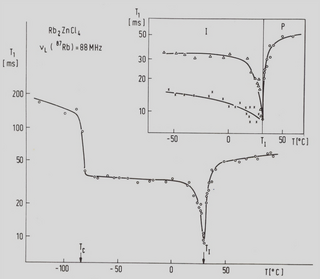
Research on phase transitions in a lipid bilayer, which represents a model of a biological membrane and is embedded into a pseudo-two-dimensional perovskite monocrystal, carried out with methods of 13C and 14N nuclear double resonance, allowed for a first ever determination of microscopic mechanism of both phase transitions in model biomembrane systems. The results of the experiments were explained using a theory that only slightly differed from the one that was used to describe phase transitions in smectic liquid crystals. Moreover, the mentioned mechanism also enabled the explanation of phase transitions in cell membranes.
Using the spin markers method, changes in the fluidity of membranes caused by the transformation of normal cells to malign ones were researched in 1979. It was discovered that changes in the dynamics of phospholipids along a hydrocarbon chain in the membrane bilayer of transformed cells are different than the ones in normal cells.
The applied research groups extensively cooperated with other disciplines. This led to development of a method for a rapid non-destructive protein content determination in grains with the help of the 13C magnetic double resonance and magic angle spinning. A digital cholesteric liquid-crystal thermometer was also developed and an agreement was reached to put this discovery into practice. Furthermore, a technology for making large liquid-crystal displays was developed, and in cooperation with Iskra, a pilot small-scale production line was implemented. What should also be mentioned is the creation of a new model of welding goggles on the basis of liquid-crystal optical switches and a laboratory prototype of a liquid-crystal oscilloscope where a cathode-ray tube is positioned with a matrix liquid-crystal screen. The Department also made an oil analyser for an oil mill in Sremska Mitrovica.
